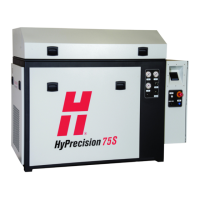188 HyPrecision 50S/60S/75S Operator Manual 808690
9 – Installation
Installation
Water
For minimum and maximum flow, pressure, and temperature requirements, refer to the Pump specifications,
which begin on page 173.
Water quality
The quality of the water supplied to the intensifier has a direct effect on the life of the pump. Poor water quality
increases operating costs by causing unnecessary wear on pump parts and shortening maintenance intervals.
Before installing this equipment, do a water quality analysis. Water quality reports that show pH, silica, and
hardness levels are frequently available for no charge from public utility water suppliers.
Total suspended solids (TSS)
Suspended solids refers to small, solid particles that are suspended in water. Filters are used to remove these
solids. Hypertherm pumps include filters that remove TSS from the cutting water.
Total dissolved solids (TDS)
Dissolved solids refers to molecular, ionized, or microgranular particles in solution in water. TDS include hard
elements such as iron, calcium, magnesium, and silica, which form deposits on the inside of high-pressure
plumbing and can damage check valves, seals, orifices, and other consumables.
Most systems require softened water. Consult a specialist for recommendations for choosing a water treatment
system. Reverse osmosis systems are available from Hypertherm.
Test the water quality
Public utility water and well water quality can change. Hypertherm recommends regular testing.
Some TDS meters require calibration before use. For best results, calibrate the meter at 25.0°C (77°F). Refer
to the instructions supplied with the TDS meter.
If multiple readings are taken, turn the meter OFF between readings.
Do not use deionized water unless the system has stainless steel water fittings. Using deionized
water in standard systems can cause the plumbing parts to fail and causes substantially shorter
consumable life.
Check local codes to determine if a backflow prevention valve is required to separate the pump from
the facility’s potable water.
If the cooling water or the low-pressure water temperature is higher than 23.9°C (75°F), cool the
water before use. Water that is too warm is inefficient for cooling and can reduce high-pressure seal
life.

